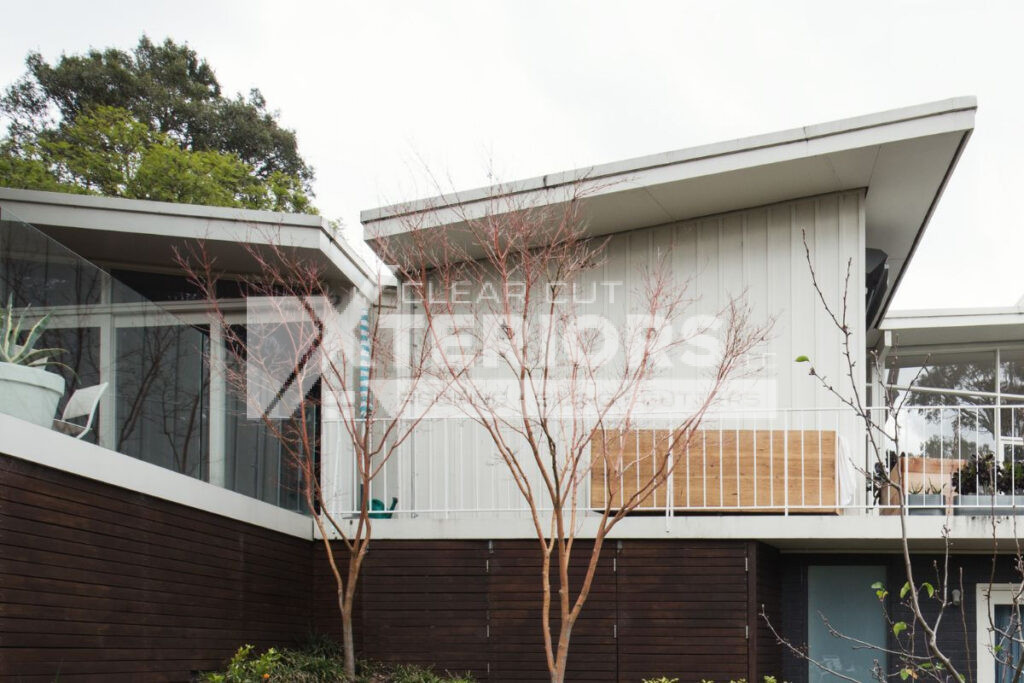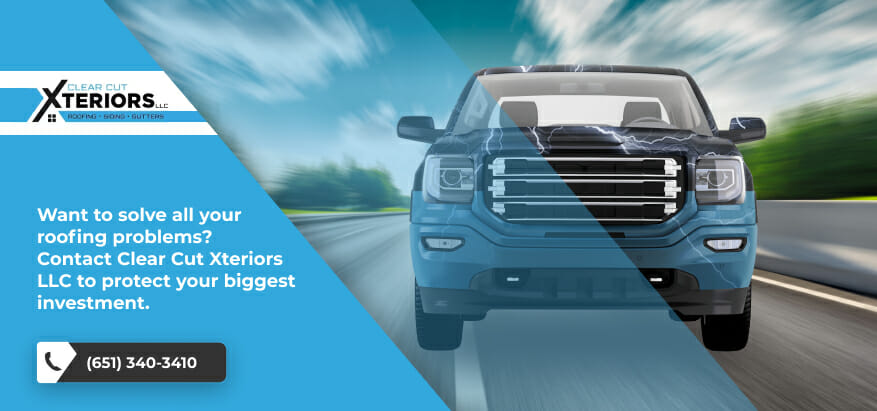Located in the heart of the Midwest, Minnesota experiences a wide range of weather conditions, from harsh winters to mild summers. Choosing the right roof for your home involves balancing style and practicality.
This blog post explores modern roof designs that are best for Minnesota’s weather, focusing on aesthetics and energy efficiency.
Best Modern Roofs For Minnesota Homeowners
#1. Butterfly Roof

A butterfly roof, also known as a V-roof or inverted roof, has a distinct V-shaped slope that improves interior space and aesthetics. This one-of-a-kind design allows for quick snow removal, lowering the risk of accumulation and potential damage, which is especially useful in snowy areas like Minnesota.
Its efficient runoff design also prevents water damage and ice dams, ensuring resistance to severe weather conditions. This combination of features makes the butterfly roof an excellent architectural choice for areas with challenging weather patterns.
- Unique Design: The butterfly roof’s inverted slope adds visual appeal.
- More Space: By inverting the slope, the butterfly roof maximizes interior room for living or other activities.
- Efficient Drainage: Its V-shape swiftly drains rainwater, reducing pooling and potential damage.
- Brighter Interiors: This design increases natural light inside, creating a brighter living environment.
#2. Skillion Roof

Featuring a single, flat surface that slopes in one direction, the skillion roof is another well-suited option for Minnesota’s weather. This design enables drainage, reducing the risk of water damage and structural issues due to the state’s frequent snowfall and heavy rainfall.
Additionally, the simplicity of the skillion roof makes it a cost-effective option for homeowners and builders, as it requires fewer materials and is easier to construct compared to more complex roof designs.
- Efficient Drainage: The slope ensures easy runoff of water and snow, lowering the risk of water damage and structural issues.
- Cost-Effective: Its simple design minimizes the need for extra materials, making it an economical choice.
- Modern Look: Skillion roofs boast clean lines and a minimalist design, offering a sleek and contemporary aesthetic.
- Eco-Friendly: The large surface area is ideal for installing solar panels and skylights, promoting energy efficiency and sustainability.
- Easy Installation: Its straightforward design makes skillion roofs popular for DIY projects and professional roofers.
#3. Mansard Roof

The next option is a mansard roof, which features four sides with two slopes on each side. The lower slope is notably steeper than the upper slope, creating additional space, often in the attic area. This design not only features an attractive aesthetic but also effectively withstands Minnesota’s weather conditions.
The steep lower slope efficiently sheds water and snow, reducing the risk of water damage and ice dams. Moreover, the design allows for proper ventilation, which is crucial in Minnesota’s humid climate. Overall, a mansard roof is an excellent choice for Minnesota homeowners seeking a functional and visually appealing roof that can endure the region’s challenging weather.
- Additional Space: The flat top of a mansard roof maximizes attic space, ideal for conversion into usable living areas.
- Dormer Windows: Typically, dormer windows are integrated into mansard roofs to enhance natural light and ventilation.
- Variety of Types: Mansard roofs are available in styles such as convex, concave, S-shaped, and straight-angled, catering to diverse architectural preferences.
- Skylights: Many mansard roofs incorporate skylights to maximize natural light and improve indoor ventilation.
#4. Gambrel Roof

The unique architectural style of the gambrel roof, featuring two distinct slopes on each side with a steeper lower pitch, lends a distinctive aesthetic often associated with barns and farmhouses. This design excels in regions with harsh weather, as the steep lower slope facilitates the efficient shedding of snow and water to minimize structural risks.
Moreover, the gambrel roof maximizes interior space while maintaining a compact exterior footprint, making it ideal for areas with limited land. Able to withstand strong winds and heavy snowfall, coupled with its classic visual appeal, this roof style is a popular choice for pole barns and agricultural structures.
- Vertical Gable Ends: Gambrel roofs feature vertical gable ends, unlike the hipped ends of mansard roofs.
- Overhanging Facade: Unlike mansard roofs, these roofs typically overhang the building’s facade.
- Increased Space: The steep lower slopes create extra storage or living space, such as an attic or loft.
- Simple Construction: This roof design is straightforward, needs fewer materials, and is less complex.
- Common Materials: Asphalt shingles, wood, slate, and sometimes metal, despite its higher cost, are used to construct this roof.
#5. Dutch Gable Roofs
A Dutch gable roof is a unique design that combines hip and gable roofs. It features a four-sloped skirt with a gable roof section at the top. This allows more natural light, ventilation, and storage space within the home. At the same time, the hip skirt can become a four-season porch or living area with ample windows, enhancing curb appeal and ventilation.
Well-suited for Minnesota weather, the design facilitates easy drainage, reduces water damage risks, and provides structural stability against strong winds and heavy snowfall, making it an excellent choice for homeowners looking for a weather-resistant, energy-efficient roof with additional living space.
- Natural Light: The gable can include windows and vaulted ceilings that create open, unique spaces.
- Energy Efficiency: Dutch gable roofs reflect heat and UV rays, reducing cooling costs and enhancing energy efficiency.
- Structural Stability: The hip skirt adds stability, making the roof more resistant to strong winds and extreme weather.
- Efficient Drainage: The design ensures easy snow and rain drainage, reducing water damage and ice dams.
- Durability: Combining hip and gable elements creates a robust structure, withstanding harsh weather like heavy snow and strong winds.
#6. Green Roof

The last and also the most unique option in our list is green roofs, which are roofing systems that incorporate vegetation and a waterproof membrane, offering sustainable and eco-friendly benefits. In Minnesota, they can easily manage the high-intensity, short-duration storms common throughout the summer months.
Additionally, they improve air quality, mitigate the urban heat island effect, and provide habitats for local wildlife. By reducing building energy costs and offering stormwater management solutions, green roofs present a valuable option for enhancing the environmental sustainability of homes in Minnesota’s climate.
- Energy Efficiency: Vegetation cuts heating and cooling costs by providing insulation and shade.
- Air Quality Improvement: Green roofs absorb pollutants and release oxygen, enhancing urban air quality.
- Aesthetic Appeal: Designed for visual appeal, green roofs enhance the look of your home.
- Native Plant Selection: Using native plants supports local ecosystems, reduces irrigation needs, and promotes sustainability.
- Integration with Other Strategies: Green roofs can be combined with other stormwater management techniques to reduce runoff further and enhance water quality.
Conclusion
While traditional roofing options have served Minnesota homeowners well, modern times call for fresh ideas that combine style and functionality. By exploring the modern roof ideas mentioned above, you can give your roof the perfect makeover.
For Minnesota homeowners, Clear Cut Xteriors provides top roofing services to improve the overall visual appeal of your home. Our skilled team of roofers delivers quality craftsmanship and 100% customer satisfaction. To get the best services, contact us today at (651) 212-5628.



